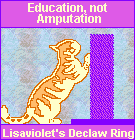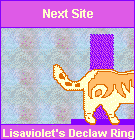

Scratching is a natural behavior for cats. This removes the dead husks from their claws, marks territory, both visually and with scent glands in their paws, and stretches their muscles. Unfortunately, what is natural behavior for a cat often is considered misbehavior by a cat's human guardian, especially when furniture or other household objects are damaged in the process.
The sensible and humane solution to undesirable scratching is to modify the cat's conduct by making changes in the environment. Many guardians, however, choose to modify their cats by having the cat's claws removed. Usually, the front claws are the only ones cut off, but some guardians also have the back claws removed.
Surgical claw removal or declawing is called onychectomy. By any name, it is an extreme measure in which the entire last part of the ten front toes are amputated. A graphic comparison in human terms would be the cutting off of a person's finger at the last joint
.General anesthesia is used for this surgery, which always has a certain degree of risk of disability or death associated with it. Because declawing provides no medical benefits to cats, even slight risk can be considered unacceptable. In addition, the recovery from declawing can be painful and lengthy and may involve postoperative complications such as infections, hemorrhage, and nail regrowth. The latter may subject the cat to additional surgery
.A less invasive procedure, called tenotomy or deep digital flexor tendonectomy, sometimes is done. In this procedure, the tendons controlling the claws are severed without removing the claws. Although postoperative problems are lessened by this procedure, the risks associated with general anesthesia still apply.
Declawing robs a cat of an integral means of movement and defense. Because they cannot defend themselves adequately against attacks by other animals, declawed cats who are allowed outdoors may be at increased risk of injury or death. Moreover, it is unknown whether declawing causes some degree of privation with respect to satisfying the instinctive impulses to climb, chase, exercise, and to mark territory by scratching.
<Some declawed cats behave as they did before they were declawed, but others undergo a profound personality change. They may become extremely timid or unusually aggressive. Whether such problems develop from the trauma of surgery or the absence of claws is a matter of speculation
.Anesthesia and postoperative analgesics may minimize the pain and discomfort experienced by cats who are declawed. It may also be that there are no long term psychological effects, if this could be assessed adequately. But, these are not the only issues and may not even be the most important issues. A major concern that the AVAR has about declawing is the attitude that is evident in this situation. The cat is treated as if he or she is an inanimate object who can be modified, even to the point of surgical mutilation, to suit a person's perception of what a cat should be. It would seem more ethical and humane to accept that claws and scratching are inherent feline attributes, and to adjust one's life accordingly if a cat is desired as a companion. If this is unacceptable, then perhaps a different companion would be in order.
Scratching Posts
Training a cat to use a scratching post is the most common alternative to declawing. Ideally, cat guardians should install scratching posts in their houses before they bring home a cat. Otherwise, guardians should put scratching posts next to the sofas, breakfronts, or carpets into which cats are currently sinking their claws.
A scratching post should be well anchored so that it will not tip over when the cat uses it. The post also should be tall enough so that the cat can stretch herself or himself while scratching. The scratching surface should be made from a strong material like sisal, hemp or carpet, whichever the cat prefers. Even better would be a combination of materials. Scratching posts, like litter pans, should be deployed on every story of the house to which a cat has access
.To teach a cat to use a scratching post, wave a toy directly in front of the post so that the cat's nails dig into the post as he or she grabs for the toy. Play this game two or three times a day for a few days and the cat will soon be climbing the post spontaneously. You could also apply some catnip to the post for additional enticement.
To keep your cat off what you do not want scratched, try changing the texture of the item, such as placing a sheet over the sofa or using aluminum foil or double sided tape on the object. You may also be able to discourage her or him by using a scent which cats generally do not like, but which is not unpleasant for human beings. One which may work is the fresh smell of citrus
.Keeping a cat's nails trimmed is another alternative to declawing. Cat guardians can lessen the amount of husk-removal scratching their cats engage in by seeing that the claws are clipped regularly. The tip of the claw should be removed along with any loose husk covering the fresh, sharper claw underneath. If their claws are clipped as needed, once every week or two, cats will have less desire to remove the husks of dead claws by scratching — an activity frequently mistaken for sharpening the claws.,/b>
To trim a cat's claws, place her or him on a table or on your lap, and facing away from you. Lift one of the legs so that the lower part of the leg rests in your upturned fingers. Holding the leg securely but non-threateningly between the heel of your thumb and the tips of your middle, ring, and little fingers, grasp the paw between your thumb and forefinger. Press down gently on top of the paw with your thumb, spreading the toes and extending the claws. Check each claw individually. Do not trim blunt or rounded claws. If the nail is honed to a talon-like point, clip it. Be careful to clip the hooked part of the claw only. Avoid cutting into the pink tissue visible inside the nail.

There are commercial products which cover the claws and reduce the need for frequent trimming of the nails. A non-toxic adhesive is used to attach a plastic cap over each claw. These are alleged to last up to 6 weeks and are not harmful if eaten by the cat.
The Association of Veterinarians for Animal Rights is opposed to cosmetic surgeries and to those performed to correct 'vices.' Declawing generally is unacceptable because the suffering and disfigurement it causes is not offset by any benefits to the cat. Declawing is done strictly to provide convenience for people.
Some veterinarians have argued that some people would have their cats killed if declawing was not an option. We should not, however, allow ourselves to taken 'emotional hostage' like this. If a person really would kill her or his cat in this case, it is reasonable to question the suitability of that person as a feline guardian, especially when there are millions of non-declawed cats living in harmony with people.
The AVAR believes that people who desire cats as companions should endeavor to learn about feline behavior prior to adopting a cat. If certain behavioral traits are unacceptable, then the desire for a cat should be reconsidered.
For people who already have cats, undesirable behavior with respect to claws should be modified by correcting deficiencies in the cat's environment or by other options such as nail clipping. Only in extreme circumstances should surgical measures such as declawing or tendon cutting be considered. What those circumstances might be are beyond the scope of this brochure, but it must be emphasized that these should be considered only a last resort after having tried all other options for resolution and only if the person will not then accept the cat on her or his terms.
The AVAR encourages veterinarians to adopt a policy which mandates that declawing or other surgery is extreme and should only be done as a last resort.
•Order copies of this brochure and distribute them to veterinarians, shelters, and the general public. •If you adopt a cat, foster her or his natural behaviors humanely. •Speak with your veterinarian about adopting a no-declawing policy. •Support the AVAR in its efforts to stop surgeries that cause suffering without benefitting the patient.
---------------------------------------------------------------------To order brochures on declawing go to Materials available from the AVAR which has a selection of different booklets and brochures available for distribution.
 | Educate!! Don't Amputate!! site owned by REN. Click here to join the ring |  |
[PREV 5 SITES | RANDOM SITE | SITELIST | NEXT 5 SITES]